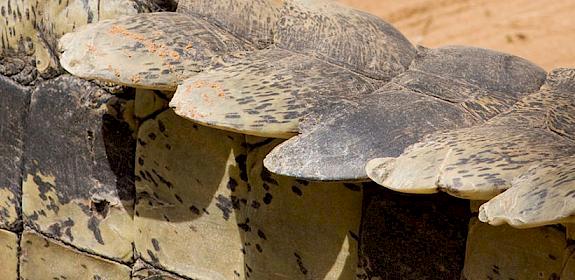New regulation denied opportunity to prevent illegal abalone harvesting
Cape Town, South Africa, 16th December 2010—Measures introduced in South Africa to bring the unsustainable and illicit trade in abalone were never given adequate support before they were withdrawn, finds a new study launched today in the TRAFFIC Bulletin.

Abalone are types of sea mollusc (known locally as perlemoen), in great demand in East Asia for their meat and shell. Overfishing and disease have caused serious declines in several species world-wide.
Numbers of one species found only in South African waters, Haliotis midae, have declined dramatically since the 1990s, largely because of highly organized illegal plundering of stocks.
The illegal fishing industry has known links to domestic drugs trafficking and Asian crime syndicates, with the majority of the catch smuggled to Hong Kong.
In an effort to regulate the harvest and prevent unsustainable and illegal exploitation of Haliotis midae, in 2007 the South African Government placed the species in Appendix III of CITES (the Convention on International Trade in Endangered Species of Wild Fauna and Flora).
An Appendix III listing is a means by which a country can ask for assistance from all other CITES member States to help control trade in a particular species.
The measure was aimed to highlight abalone trade passing illegally through neighbouring countries and was the first time CITES measures had been used to regulate international trade in any abalone species.
“While it seems clear that the listing only had a temporary impact on illegal harvest and trade in the species, it was never properly implemented in South Africa and its potential as a regulatory and monitoring tool was therefore never properly tested,” finds the TRAFFIC study.
The listing was withdrawn in May 2010 with the South African Government citing administrative difficulties, principally owing to misunderstandings around the role of the various government agencies in CITES permit endorsement.
“The withdrawal of Haliotis midae from CITES Appendix III is troubling as it appears to be based on institutional constraints, rather than a fundamental flaw in the CITES instrument and process,” said Markus Bürgener, Senior Programme Officer with TRAFFIC East/Southern Africa, and author of the report.
According to Bürgener, the Government should investigate affording Haliotis midae and similar looking abalone species greater protection under CITES, backed up with adequate resources.
“Almost all abalone range States experience illegal harvest and a CITES listing could assist compliance efforts for species found in these countries,” he said.
Other features in the latest edition of the TRAFFIC Bulletin—the only peer-reviewed journal dedicated to studies of the global trade in wildlife—include an investigation into the poaching of Malayan Sun Bears in Malaysia where they are in demand for use in traditional medicines and for their meat. It is hoped that new legislation introduced in that country will have a deterrent effect on this illegal trade.
The Bulletin also includes a comprehensive report of the 15th meeting of the Conference of the Parties to CITES. An editorial on this theme examines the future direction of this Convention in the light of the Doha meeting and the failure there to address some serious conservation management challenges.
TRAFFIC Bulletin 23(1), including all the above articles plus much more.



